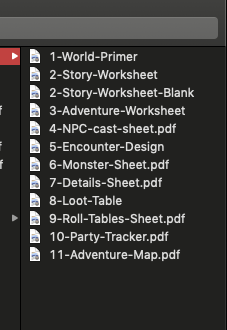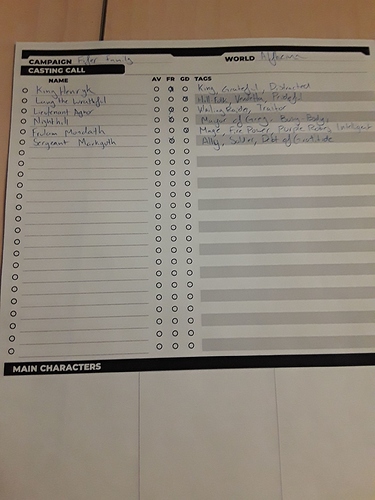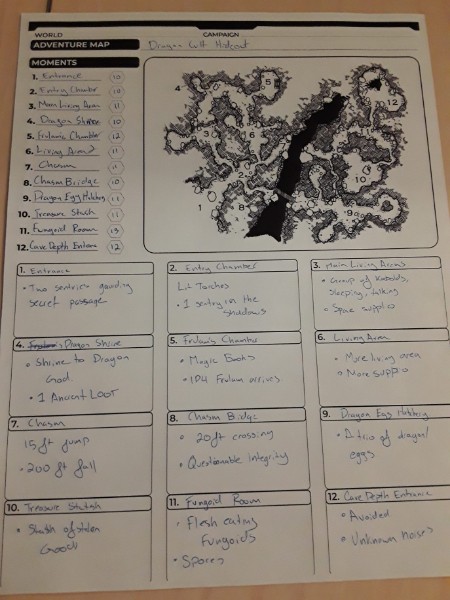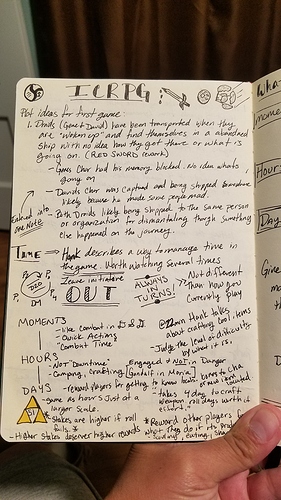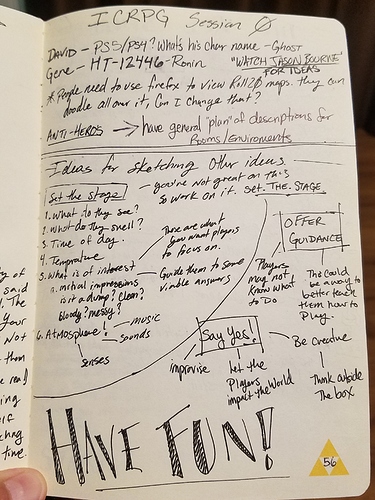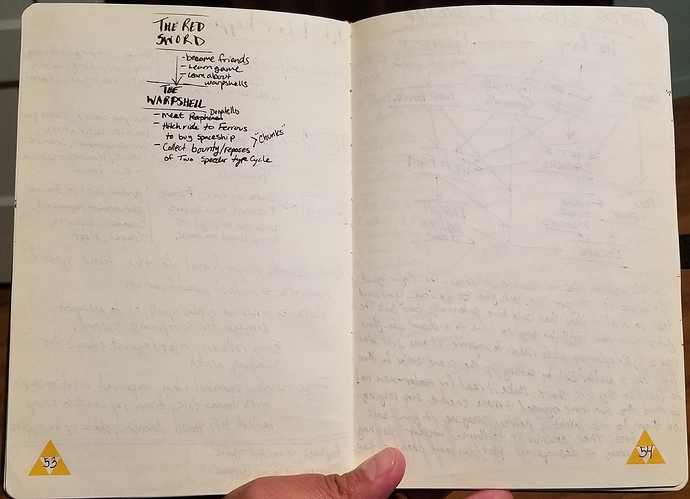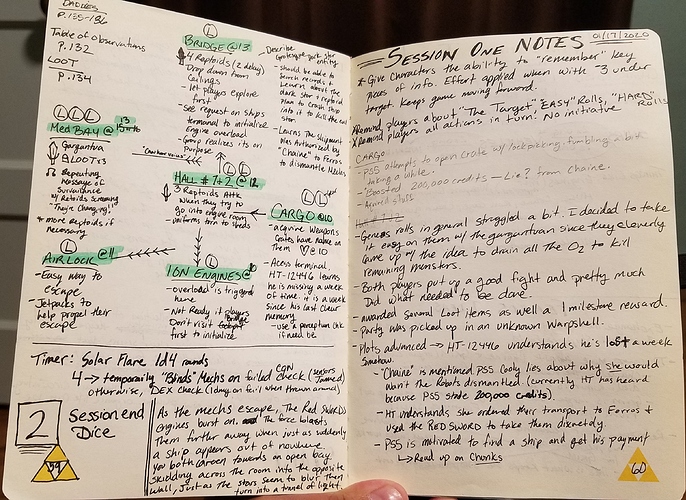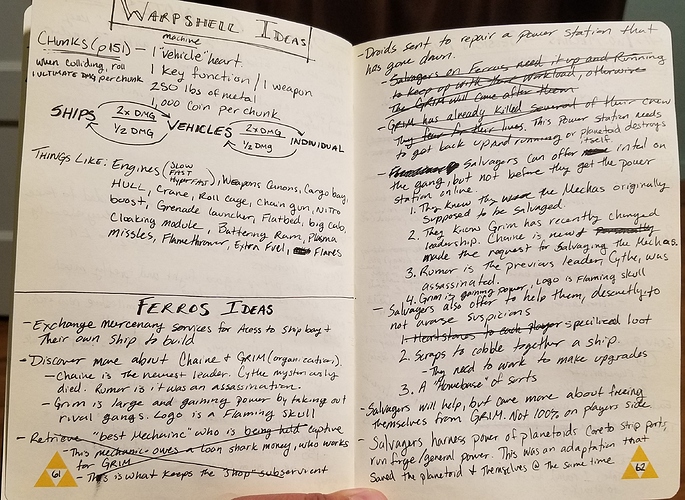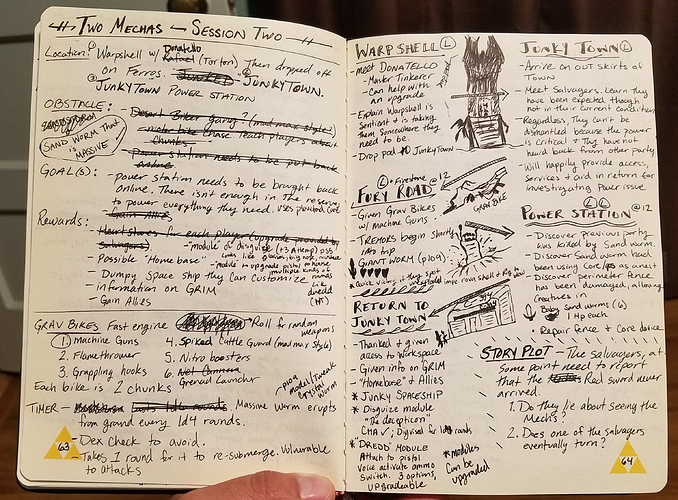Figured i’d throw my journal into the ring since I think i’m starting to develop my own prep style. This is my process from start (back in december) to now of an ICRPG campaign I just started where the two PCs are Mecha anti-heros. The gist of the characters can be described as “Chainsaw wielding robot who is crude, rude, theiving yet loveable scamp and not above murdering people teamed up with a bounty hunting/mercenary trying to accumulate riches and b*tches” There are a lot of scribbling and marked out things that can look a bit chaotic at times. Sorry in advance for the long post, there’s lots of pictures though  :
:
These are my very first notes from when I decided to look into ICRPG. I revisited Hank’s videos and even jotted down some notes about turns and time down near the bottom. The top of the page had just a few ideas I had for a campaign to run with a couple of my friends from my very first D&D group (over 15 years ago!). They simply told me the bio-form and class they were interested in and I ran with it.
A few more notes the players gave me about their characters on top of some reminders for myself. When I wrote this page I had just experienced one of my worst game sessions in my 5E D&D game (i’m running Hoard of the Dragon Queen). I described it as an “absolute sh*tshow” and I knew that most of the blame for that fell on me as the DM. I felt that I didn’t set them up for success, which frustrated them because they were kind of aimless and that frustrated me because they wouldn’t just decide on something to do. I ended the session early despite them wanting to keep going. I just wanted it to end so I could regroup and figure out where it had gone so wrong. I had noticed that my description of the scenery/environment/surrounds had been lacking for serveral games as they kept asking me questions about their surroundings and this exercise reinforced to myself that it was something I needed to spend more time with. Not necessarily go into extreme detail, but more than I have been.
My initial campaign plan. Notice, it’s mostly blank. Advice I am heeding from Hank and this forum. I just have a couple known points to start and the rest will get filled in as the campaign plays out. I am really excited to see what this page turns into as my players explore (and subsequently create) the universe.
Now begins my first session planning. I knew I wanted to run The Red Sword adventure and just made a few modifications to fit our story. Notice I wrote A LOT of descriptions, almost like a script. I found this really helpful for me and It will be something i’ll keep experimenting with to improve my describing skills. Sometimes I get nervous when the game starts and i’ll forget what I want to say so having this mini script made sure I said what I wanted to say. Bullets would help too, but I have found that approach to make it feel empty and lacking the kind of emotional response I’m looking for. For now, i’ll write myself these little paragraphs as I keep working on it. Also, some doodling going on here. I’m not the best but I sure do have fun with it.
I then broke down the different rooms and made small notes about what would happen. the “L” inside the circle stands for each piece of loot I would award if/when they came across it. I also noted the room target and made sure to highlight them so I could easily find them as I ran the game. For those of you who have run The Red Sword, I replaced the “Science Bay” with the “Cargo Bay” as my PCs were being shipped to a planetoid called “Ferros” to be dismantled permanently. This is where their adventure started. This little chart functioned as a map as well and really worked well for me. Everything I needed, except for the monsters and loot, was on this one page (on the left). The right side of the page are my notes from the session. The pencil notes were taken during and I later came back and filled in some notes in pen afterwards. One important note on the bottom of the right page for me being to read up on “Chunks” to prep for the next session.
Using my notes from the first session, I jotted down a few notes on Chunks from Core2E book and then started to brainstorm ideas for the next session. I wrote everything that came to mind and spent a few days mulling this over, crossing out ideas that I either didn’t like (like making the hook to retrieve a mechanic being held captive at the bottom of the left page. I’m glad I didn’t stick to this) or couldn’t make fit for this particular session. The ideas that stayed were hashed out in this next set of pages. I also included ideas for specialized loot instead of randomly rolling all of their loot like I did the first game.
Here I started to outline the framework of my second session using LOG. More marked out ideas that were replaced. This was very much an evolving plan. Following a similar structure I did for the first session, I wrote the “room” and started to write target numbers for myself. My session isn’t for another 2 weeks so I still have plenty of time to make any adjustments and add doodles as necessary. I designed character specific loot that I noted at the bottom of the right page including a “disguise module” that looks like those novelty glasses with the nose and mustache. For some reason, the idea of that terrible disguise actually being a rather useful disguise enhancing item was hilarious to me and I know the player it is for will love it and find it just as funny as I did. My other player is playing a Ronin and generally wants to be a super tough mercenary (He just finished watching The Mandalorian) so I decided giving him a module to modify his blast pistol to be like the “Lawgiver” from Dredd where we can have up to three different ammo types (of my choosing) that he can change with a voice command. If he chooses to upgrade it to have more ammo choices, i’ll allow him to.
This last set of pages is a sketched out idea of what Junky Town will be like. I have a feeling they’ll want to stay in this place for at least one more session, so I wanted to have any details at least sketched out about the place ready, including buildings and NPCs they might run into. A few of the NPCs I know they will for sure interact with but I made a couple more “just in case”. The page on the right has a list of inforamation the PCs will learn as they try to unravel how they ended up on the Red Sword in the first place and why someone wants them to be dismantled so bad. “Chaine” is a name that has continued to pop up for them, first on the shipping manifest they discovered back on The Red Sword. There are lots of other details about the campaign I haven’t mentioned but I figured this post is long enough already. If anyone is interested i’ll be happy to share more about it.
Man, that was long! The pen and paper route is part of my current process and so far I am finding it both satisfying and helpful. Being OK with scratching things out has made me feel more free and more confident to create. In addition, the doodling and not caring one bit about what it looks like and even posting it here for everyone to see is helping too. All the info and advice on this forum has really taken my skills and process to another level. I don’t find DMing nearly as daunting and difficult as I did in the beginning. I still consider myself a novice DM and I hope that any other novices out there reading this will see that they can do this too.


